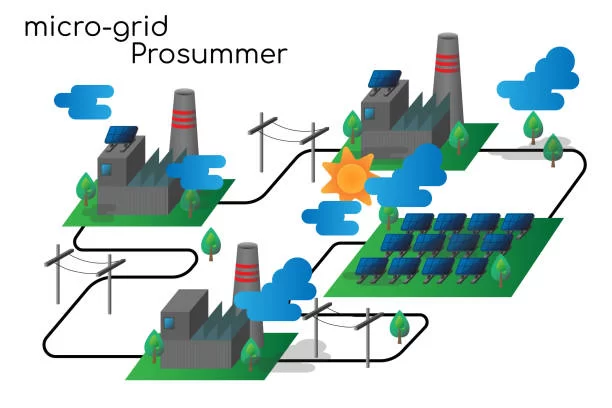The Advantages and Limitations of Energy Storage Systems in Microgrids
In recent years, the concept of microgrids has gained significant attention as a promising solution for reliable and sustainable power supply. An essential component of microgrids is the energy storage system, which plays a crucial role in enhancing the performance and functionality of these localized power networks. This article aims to explore the advantages and limitations of energy storage systems in microgrids.

Advantages of Energy Storage Systems in Microgrids
- One of the primary advantages of energy storage systems in microgrids is the improvement in power supply reliability. Microgrids, especially in remote or isolated areas, are prone to disruptions in the main power grid. Energy storage systems act as a buffer, providing immediate backup power during outages or faults. This ensures the continuous operation of critical loads such as hospitals, emergency response facilities, and data centers. For instance, in a rural microgrid, when the main grid connection is lost due to a storm or other natural disasters, the stored energy can keep essential services running until the main grid is restored.
Another significant advantage is the smoothing of renewable energy generation. Renewable energy sources like solar and wind are intermittent and variable by nature. Energy storage systems can store excess energy during periods of high generation and release it when the output from renewables is low. This helps to stabilize the power output and reduces the impact of fluctuations on the microgrid. Consider a solar-powered microgrid; on a sunny day with high solar irradiation, the excess energy generated can be stored and then utilized during cloudy or nighttime hours, ensuring a consistent power supply.
Energy storage systems also contribute to optimizing the power quality within the microgrid. They can quickly respond to changes in load and generation, absorbing or injecting power to maintain the voltage and frequency within the acceptable range. This helps to minimize power fluctuations, reduce harmonic distortion, and prevent voltage sags or swells, thereby protecting sensitive equipment and ensuring the efficient operation of electrical devices.
In addition, they offer the potential for cost savings. By storing energy during off-peak hours when electricity prices are low and discharging it during peak hours when prices are high, microgrid operators can reduce their electricity bills. This demand-side management strategy can lead to significant economic benefits, especially for commercial and industrial microgrids with high electricity consumption.
Furthermore, energy storage systems enhance the autonomy and independence of microgrids. They enable microgrids to operate independently of the main grid for extended periods, reducing reliance on external power sources. This is particularly valuable in areas where the main grid is unreliable or where there is a desire to achieve greater energy self-sufficiency.
Finally, they facilitate the integration of distributed energy resources. Microgrids often incorporate a diverse range of distributed generation sources such as small-scale wind turbines, photovoltaic panels, and micro-CHP units. Energy storage systems help to balance the varying outputs of these distributed resources, allowing for a more efficient and reliable operation of the microgrid as a whole.
Limitations of Energy Storage Systems in Microgrids·
- Despite the numerous advantages, energy storage systems in microgrids also come with certain limitations. One of the major challenges is the high initial cost. The cost of purchasing and installing energy storage systems, including batteries, supercapacitors, or flywheels, can be substantial. This cost factor can pose a significant barrier to the widespread adoption of energy storage in microgrids, especially for smaller-scale or budget-constrained projects.
Another limitation is related to the energy density and power density of the storage technologies. Different storage options have varying capabilities in terms of the amount of energy they can store and the rate at which they can deliver or absorb power. For some applications, achieving a balance between high energy storage capacity and high power output can be difficult. This can limit the suitability of certain storage technologies for specific microgrid requirements.
The cycle life and degradation of storage devices are also significant concerns. Most energy storage systems have a limited number of charge-discharge cycles before their performance starts to deteriorate and their capacity reduces. This requires regular maintenance and eventual replacement, adding to the overall lifecycle cost of the storage system. For example, lithium-ion batteries, although offering high performance, have a limited cycle life that needs to be taken into account in long-term planning.
Self-discharge is another issue that affects the efficiency of energy storage. Some storage technologies, especially over longer periods of time, may lose a portion of the stored energy even when not in use. This can be a drawback in scenarios where energy needs to be stored for extended durations.
The physical space requirements for large-scale energy storage systems can be a constraint, especially in densely populated or land-constrained areas. Installing and accommodating the necessary equipment may pose challenges in terms of finding suitable locations.
Environmental considerations are also important. The production, disposal, and potential leakage of substances from some energy storage technologies can have environmental impacts. Ensuring proper handling and recycling of storage devices is crucial to minimizing the ecological footprint.
Energy conversion efficiency losses during the charging and discharging processes are inevitable. Some of the input energy is lost as heat or other forms of dissipation, reducing the overall efficiency of the energy storage and utilization system.Finally, there are safety risks associated with energy storage systems, particularly related to overheating, fire, or explosion in the case of battery systems. Adequate safety measures and monitoring systems are necessary to mitigate these risks.
In conclusion, energy storage systems offer significant advantages in microgrids, including enhanced reliability, improved power quality, cost savings, and increased autonomy. However, they also face limitations such as high initial costs, technical performance limitations, and environmental and safety concerns. To fully realize the potential of energy storage in microgrids, ongoing research and development efforts are needed to address these limitations and make energy storage systems more economically viable, efficient, and sustainable.
